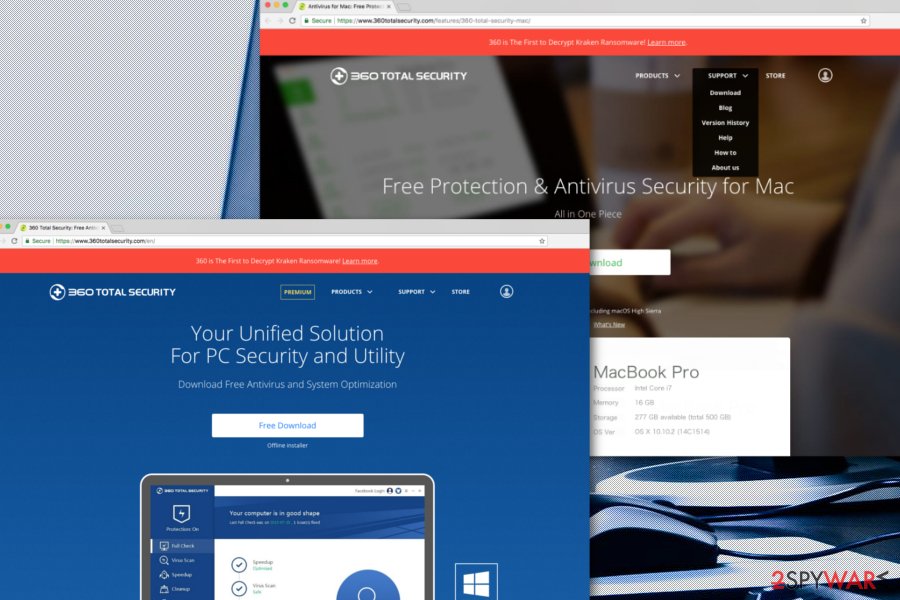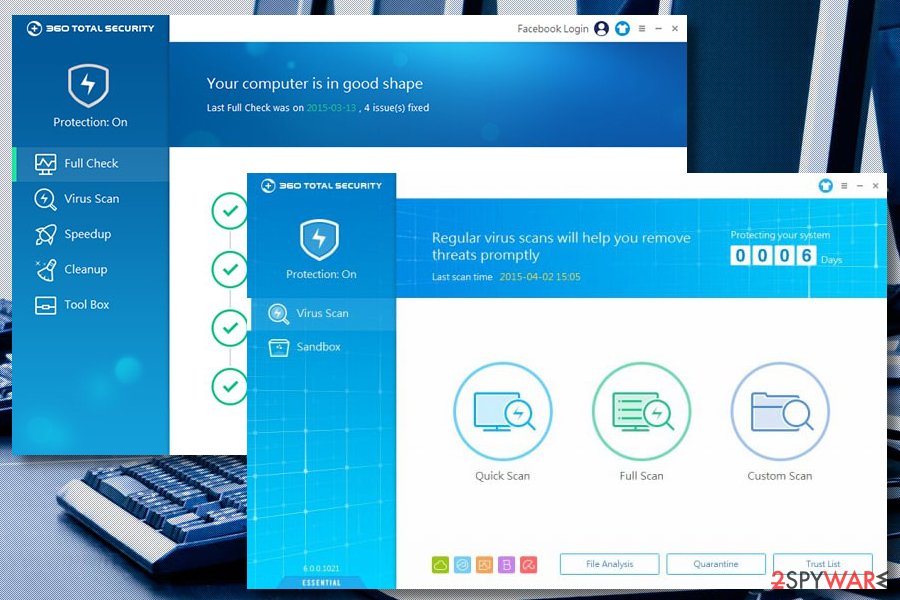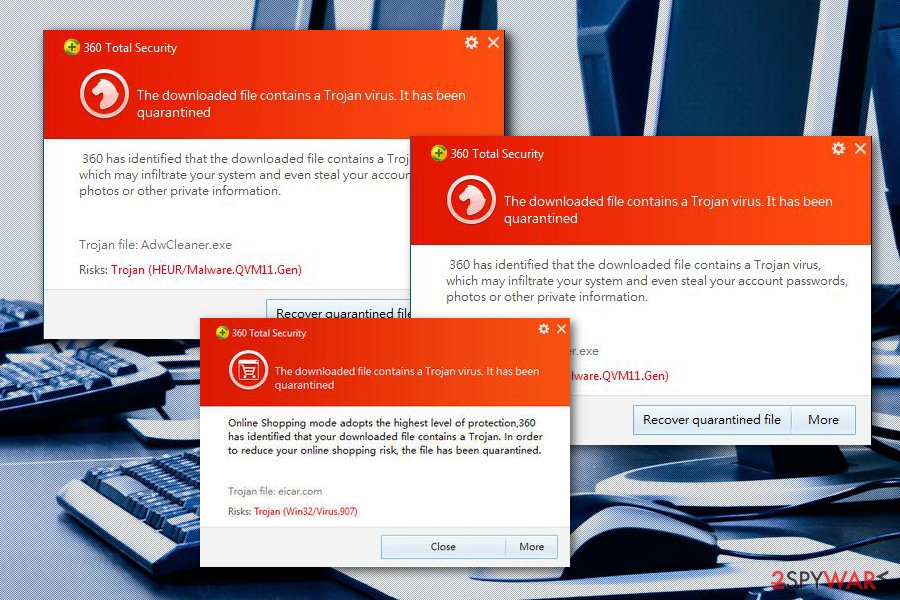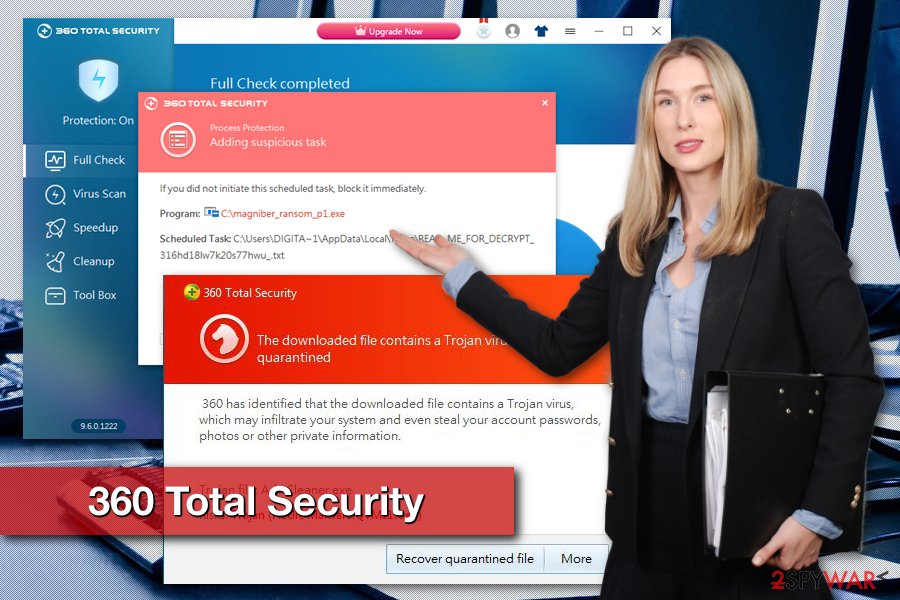360 Total Security virus (Easy Removal Guide) - updated May 2018
360 Total Security virus Removal Guide
What is 360 Total Security virus?
360 Total Security – a poor security software

360 Total Security is a suspicious antivirus program created by the Chinese company called Qihu 360 Software Co Ltd. This program does not only offers poor protection from cyber threats but might get into the system unnoticed and aggressively urge to obtain the license key too.
| Summary | |
|---|---|
| Name | 360 Total Security |
| Developer | Qihu 360 Software Co Ltd |
| Type | Potentially unwanted program |
| Danger level | Medium. Can get installed unnoticed and bring other unwanted apps to the system |
| Symptoms | Sudden system scans and virus alerts |
| Distribution methods | Official website, third-party download sources, freeware and shareware downloads |
| To uninstall 360 Total Security, install FortectIntego and run a full system scan | |
So-called 360 Total Security virus is identified as a potentially unwanted program (PUP),[1] and has been actively distributed for a couple of years. Among the most affected users are located in the United States, India,[2] and Egypt. At the moment of writing, it's compatible with Windows and Mac operating systems.

From the first glimpse, 360 Total Security may seem as a genuine anti-spyware.[3] It claims to be able to detect viruses, Trojans, and other emerging threats. According to the test results, the program does not detect major cyber threats and might provide fake system scan results.
Hence, 360 Total Security might inform about non-existent cyber threats on your computer. This sneaky technique is used to convince you to buy a license key of this questionable program. However, even the paid version of the program does not help to clean computer.
360 Total Security program has an official download website. However, it often sneaks into the system bundled with various free programs. What is worse, it does not arrive on the system alone. It might also bring Bitdefender and Avira engines or other PUPs.

If 360 Total Security manages to infiltrate a computer, it adds a scheduled task to Windows Task Scheduler and launches at certain scheduled times. Besides, it connects to the Internet and adds a Windows Firewall[4] so that a genuine anti-spyware would not block it.
In addition to that, it installs a shortcut on the Internet and continuously runs the executable qhsafemain.exe in Task Manager. It seems that it is responsible for continuously displaying misleading 360 Total Security alerts.
Of course, you can stop these annoying activities. First of all, you have to uninstall 360 Total Security from Windows. However, we have told that it might bring other unwanted apps to the system, so you should find and get rid of all these entries.

If you want to remove 360 Total Security together with its related components manually, you can follow our prepared guide at the end of this article. Keep in mind that attentiveness is needed. Otherwise, you might overlook some of the PUP-related components.
However, if you have problems with 360 Total Security removal or want to speed up the procedure, you should opt for automatic elimination method. You have to obtain a professional anti-malware software, such as FortectIntego, and run a full system scan.

Advertising and distribution methods of the rough antivirus
Despite the fact that this suspicious security tool has an official download website; this tool might sneak into the system using other techniques. Authors of the program might use the following methods to promote and install a program on as many computers as possible:
- fake update alerts,[5]
- fake online scanners,
- malicious links
- freeware or shareware downloads.
Users are most likely to experience 360 Total Security hijack when they download free programs carelessly. If you rely on Standard/Recommended installation settings, you should ditch this habit right now! It’s the main way how PUPs enter the machine.
These settings do not openly disclose what additional apps might be included in the same package as a free program. Hence, all of the entries get into the system silently without asking user’s permission. Fortunately, you can switch to Advanced/Custom setup and avoid this unpleasant situation.
Additionally, it is recommended to stay away from security alerts popping up on the screen while browsing the web or trying free online scanners to check if your device is not infected. Such ads are typically malicious.
Uninstall 360 Total Security antivirus entirely
We have briefly mentioned two possible ways to remove 360 Total Security from Windows OS. If you are willing to get rid of the program and its related components manually, follow these steps:
- Click Start and select Control Panel.
- Click Uninstall a Program under Programs.
- Choose 360 Total Security and select the Uninstall/Change option.
- Click Yes and OK to save the changes.
Additionally, you should check your web browsers from unknown extensions or search engines. This tool is known for installing Bitdefender and Avira engines. We highly suggest terminating these tools because they might have features of the browser hijackers. You can find more information on how to fix your browsers below. Additionally, you can opt for automatic 360 Total Security removal.
You may remove virus damage with a help of FortectIntego. SpyHunter 5Combo Cleaner and Malwarebytes are recommended to detect potentially unwanted programs and viruses with all their files and registry entries that are related to them.
Getting rid of 360 Total Security virus. Follow these steps
Uninstall from Windows
Follow these steps to uninstall 360 Total Security and other questionable programs:
Instructions for Windows 10/8 machines:
- Enter Control Panel into Windows search box and hit Enter or click on the search result.
- Under Programs, select Uninstall a program.

- From the list, find the entry of the suspicious program.
- Right-click on the application and select Uninstall.
- If User Account Control shows up, click Yes.
- Wait till uninstallation process is complete and click OK.

If you are Windows 7/XP user, proceed with the following instructions:
- Click on Windows Start > Control Panel located on the right pane (if you are Windows XP user, click on Add/Remove Programs).
- In Control Panel, select Programs > Uninstall a program.

- Pick the unwanted application by clicking on it once.
- At the top, click Uninstall/Change.
- In the confirmation prompt, pick Yes.
- Click OK once the removal process is finished.
Delete from macOS
Remove items from Applications folder:
- From the menu bar, select Go > Applications.
- In the Applications folder, look for all related entries.
- Click on the app and drag it to Trash (or right-click and pick Move to Trash)

To fully remove an unwanted app, you need to access Application Support, LaunchAgents, and LaunchDaemons folders and delete relevant files:
- Select Go > Go to Folder.
- Enter /Library/Application Support and click Go or press Enter.
- In the Application Support folder, look for any dubious entries and then delete them.
- Now enter /Library/LaunchAgents and /Library/LaunchDaemons folders the same way and terminate all the related .plist files.

Remove from Microsoft Edge
Delete unwanted extensions from MS Edge:
- Select Menu (three horizontal dots at the top-right of the browser window) and pick Extensions.
- From the list, pick the extension and click on the Gear icon.
- Click on Uninstall at the bottom.

Clear cookies and other browser data:
- Click on the Menu (three horizontal dots at the top-right of the browser window) and select Privacy & security.
- Under Clear browsing data, pick Choose what to clear.
- Select everything (apart from passwords, although you might want to include Media licenses as well, if applicable) and click on Clear.

Restore new tab and homepage settings:
- Click the menu icon and choose Settings.
- Then find On startup section.
- Click Disable if you found any suspicious domain.
Reset MS Edge if the above steps did not work:
- Press on Ctrl + Shift + Esc to open Task Manager.
- Click on More details arrow at the bottom of the window.
- Select Details tab.
- Now scroll down and locate every entry with Microsoft Edge name in it. Right-click on each of them and select End Task to stop MS Edge from running.

If this solution failed to help you, you need to use an advanced Edge reset method. Note that you need to backup your data before proceeding.
- Find the following folder on your computer: C:\\Users\\%username%\\AppData\\Local\\Packages\\Microsoft.MicrosoftEdge_8wekyb3d8bbwe.
- Press Ctrl + A on your keyboard to select all folders.
- Right-click on them and pick Delete

- Now right-click on the Start button and pick Windows PowerShell (Admin).
- When the new window opens, copy and paste the following command, and then press Enter:
Get-AppXPackage -AllUsers -Name Microsoft.MicrosoftEdge | Foreach {Add-AppxPackage -DisableDevelopmentMode -Register “$($_.InstallLocation)\\AppXManifest.xml” -Verbose

Instructions for Chromium-based Edge
Delete extensions from MS Edge (Chromium):
- Open Edge and click select Settings > Extensions.
- Delete unwanted extensions by clicking Remove.

Clear cache and site data:
- Click on Menu and go to Settings.
- Select Privacy, search and services.
- Under Clear browsing data, pick Choose what to clear.
- Under Time range, pick All time.
- Select Clear now.

Reset Chromium-based MS Edge:
- Click on Menu and select Settings.
- On the left side, pick Reset settings.
- Select Restore settings to their default values.
- Confirm with Reset.

Remove from Mozilla Firefox (FF)
Remove dangerous extensions:
- Open Mozilla Firefox browser and click on the Menu (three horizontal lines at the top-right of the window).
- Select Add-ons.
- In here, select unwanted plugin and click Remove.

Reset the homepage:
- Click three horizontal lines at the top right corner to open the menu.
- Choose Options.
- Under Home options, enter your preferred site that will open every time you newly open the Mozilla Firefox.
Clear cookies and site data:
- Click Menu and pick Settings.
- Go to Privacy & Security section.
- Scroll down to locate Cookies and Site Data.
- Click on Clear Data…
- Select Cookies and Site Data, as well as Cached Web Content and press Clear.

Reset Mozilla Firefox
If clearing the browser as explained above did not help, reset Mozilla Firefox:
- Open Mozilla Firefox browser and click the Menu.
- Go to Help and then choose Troubleshooting Information.

- Under Give Firefox a tune up section, click on Refresh Firefox…
- Once the pop-up shows up, confirm the action by pressing on Refresh Firefox.

Remove from Google Chrome
Reset Google Chrome to get rid of suspicious search engines that may have been installed together with a primary program:
Delete malicious extensions from Google Chrome:
- Open Google Chrome, click on the Menu (three vertical dots at the top-right corner) and select More tools > Extensions.
- In the newly opened window, you will see all the installed extensions. Uninstall all the suspicious plugins that might be related to the unwanted program by clicking Remove.

Clear cache and web data from Chrome:
- Click on Menu and pick Settings.
- Under Privacy and security, select Clear browsing data.
- Select Browsing history, Cookies and other site data, as well as Cached images and files.
- Click Clear data.

Change your homepage:
- Click menu and choose Settings.
- Look for a suspicious site in the On startup section.
- Click on Open a specific or set of pages and click on three dots to find the Remove option.
Reset Google Chrome:
If the previous methods did not help you, reset Google Chrome to eliminate all the unwanted components:
- Click on Menu and select Settings.
- In the Settings, scroll down and click Advanced.
- Scroll down and locate Reset and clean up section.
- Now click Restore settings to their original defaults.
- Confirm with Reset settings.

Delete from Safari
Remove unwanted extensions from Safari:
- Click Safari > Preferences…
- In the new window, pick Extensions.
- Select the unwanted extension and select Uninstall.

Clear cookies and other website data from Safari:
- Click Safari > Clear History…
- From the drop-down menu under Clear, pick all history.
- Confirm with Clear History.

Reset Safari if the above-mentioned steps did not help you:
- Click Safari > Preferences…
- Go to Advanced tab.
- Tick the Show Develop menu in menu bar.
- From the menu bar, click Develop, and then select Empty Caches.

After uninstalling this potentially unwanted program (PUP) and fixing each of your web browsers, we recommend you to scan your PC system with a reputable anti-spyware. This will help you to get rid of 360 Total Security registry traces and will also identify related parasites or possible malware infections on your computer. For that you can use our top-rated malware remover: FortectIntego, SpyHunter 5Combo Cleaner or Malwarebytes.
How to prevent from getting system tools
Protect your privacy – employ a VPN
There are several ways how to make your online time more private – you can access an incognito tab. However, there is no secret that even in this mode, you are tracked for advertising purposes. There is a way to add an extra layer of protection and create a completely anonymous web browsing practice with the help of Private Internet Access VPN. This software reroutes traffic through different servers, thus leaving your IP address and geolocation in disguise. Besides, it is based on a strict no-log policy, meaning that no data will be recorded, leaked, and available for both first and third parties. The combination of a secure web browser and Private Internet Access VPN will let you browse the Internet without a feeling of being spied or targeted by criminals.
No backups? No problem. Use a data recovery tool
If you wonder how data loss can occur, you should not look any further for answers – human errors, malware attacks, hardware failures, power cuts, natural disasters, or even simple negligence. In some cases, lost files are extremely important, and many straight out panic when such an unfortunate course of events happen. Due to this, you should always ensure that you prepare proper data backups on a regular basis.
If you were caught by surprise and did not have any backups to restore your files from, not everything is lost. Data Recovery Pro is one of the leading file recovery solutions you can find on the market – it is likely to restore even lost emails or data located on an external device.
- ^ Chris Hoffman. PUPs Explained: What is a “Potentially Unwanted Program”?. How-to Geek. The website explains technology.
- ^ Vayarasa. Vayarasa. Cyber security news from India.
- ^ Anti-spyware. Techopedia. Explains latest tech buzzwords.
- ^ What is a firewall?. Microsoft. Safety and security center.
- ^ Dion Dassanayake. Google Chrome WARNING - Beware of FAKE updates that will fill your computer with malware. Express Co UK. Latest UK and World news.























